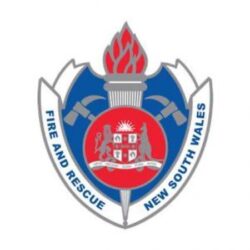Ultimate Guide to Smoke Alarms
WARNING: If you do not know which smoke alarms failed in more than 90% of Fire & Rescue NSW tests, then you MUST read this guide
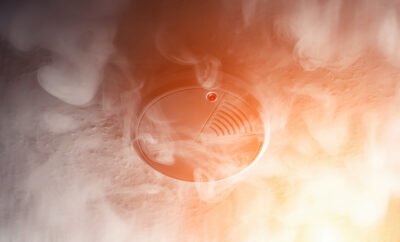
If your home catches fire and was built anytime since around 1970, you probably have less than five minutes to safely escape if you are lucky. Unfortunately, recent research shows that fire alarms often fail to activate in modern homes before smoke and heat dangerously hinder escape.
Despite minimum legal requirements for smoke alarms, a 2017 analysis of smoke alarms by Fire & Rescue NSW raised serious concerns about the reliability of commonly used smoke alarms. We’ve prepared this guide because we believe you need to know 1) which smoke alarms to choose, 2) where to have them installed, and 3) the necessary precautions to prevent false alarms and fires in your home.
Three critical excerpts from the FRNSW report summary follow:-
- smoke alarms are not providing effective notification for safe egress (escape path) when located only in the hallway. When room of fire origin alarms are also included, the results still fall short of acceptable levels.
- The best performing alarms were in “dead space” positions, positions not recommended as per NSW legislation, Australian Standards, and the Building Code of Australia.
- Photoelectric and dual alarms were found to produce statistically superior results, with ionisation alarms clearly inferior in performance.
To read which alarms failed to activate 40% – 100% of the time (during testing) read the summary of the full report here: Fire research report – Smoke Alarms in Homes: An Analysis
In addition to these somewhat concerning results, the same report also declares that modern homes pose a significantly higher hazard to residents during a structure fire than homes built before 1970. The increased use of petroleum-based synthetic furnishings, carpets and building materials, which burn faster, hotter and with exponentially more toxicity, have significantly reduced the time of tenable conditions in terms of visibility and heat.
Safe Escape Tenability Limits: Smoke Alarms Save Lives [When Activated in Time]
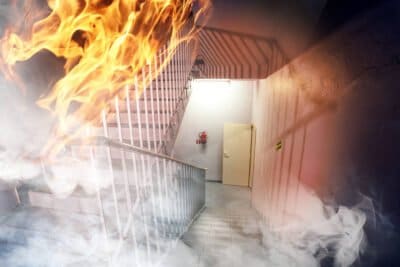

To save lives smoke alarms, need to activate while the conditions within a building remain tenable. These limits are as follows: –
- visibility limits, the escape paths should maintain a layer of at least 2.5m above floor level or minimum visibility of 10m through any smoke for people to see and reach the exits without undue hindrance.
- Heat limits, the smoke layer temperature should not exceed 200 degrees above which, any escape below such hot smoke layer would be deemed untenable.
Five Steps to Ensure Fire Safety in Your Home
So what do you need to do to ensure your family can safely escape a fire in your home? In this guide, we offer advice to help you:-
- Understand how smoke alarms (and fires) work
- Know your current legal requirements
- Install smoke alarms based on FRNSW recommendations
- Invest in good quality smoke alarms
- Limit complacency due to false alarms
Photoelectric Alarms (Optical Sensors) are Best for Smoldering Fires
Photoelectric smoke alarms detect the presence of smoke using one of two types of optical detectors that trigger the alarm when either:-
- Smoke obscures the light beam sent between a source and sensor within the system.
- Smoke scatters light causing refracted light to be detected by the photodiode (sensor).
Light obscuring optical sensors work on the principle that when particles of smoke cross the path of light in the detector, the smoke obscures the light resulting in less light from the transmitter (source) entering the receiver (sensor). At a certain threshold, the alarm is triggered.
Light scattering optical sensors are designed so that the light source does not typically fall on the photodiode sensor. When smoke enters the chamber, light is scattered by both reflection and refraction onto the sensor. The alarm is triggered once the amount of light falling on the sensor reaches the preset criteria.
Photoelectric smoke alarms with optical sensors are sensitive to visible particles that are larger than 1 micron in size (> 0.001mm), as would be common in the case of smouldering fires.


A smouldering fire is a slow-burning, low temperature, flameless combustion. These fires produce larger organic by-products, higher quantities of soot and irritant smoke with peak temperatures ranging between 500-700 degrees Celsius. The leading source of smouldering fire is cigarettes.
Items in your home that are more prone to a smouldering fire include:-
- cotton fabrics & cotton batting
- latex foam padding
- tolid materials such as coal, wood and peat
- Tobacco
- paper
- polyurethane foam
The danger with smouldering fires is two-fold: their ability to transition to flaming fires and the accumulation of smoke. In one example provided by the FRNSW, a cigarette fallen on a cotton mattress is sure to spread and, in two out of five cases, transition to a flaming fire within 90 minutes, by which point lethal levels of CO had been reached.
Ionisation Smoke Alarms (Motion Sensors) are Best for Flaming Fires
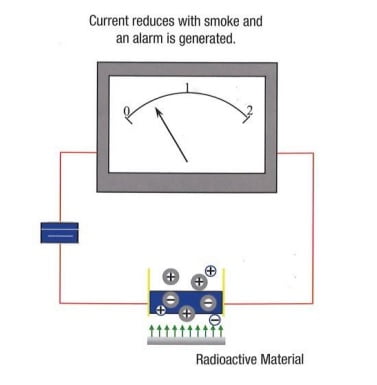

Ionisation smoke alarms are designed using a relatively safe amount of radioactive material – Americium-241 – that ionises the air between charged electrodes within the alarm. The alarm is activated when smoke particles enter a chamber on the alarm and limit the (preset criteria) movement of the ionised air.
Ionisation alarms are designed to be responsive to small and invisible particles of less than 1 micron in size (0.001mm), the type produced during flaming fires.
Flaming fires exhibit a visible flame and produce much higher quantities of “invisible” sized particles due to more complete combustion. While they tend to have non-irritating smoke, peak temperatures can not be survived, ranging upwards of 1500 to 1800 degrees Celsius.
And even before reaching such deadly peaks, flaming fires have the potential to “Flashover”, transitioning suddenly from one area to all surrounding combustible surfaces as they simultaneously reach ignition temperature due to radiant heat transfer.
Flashover is likely to occur when the ceiling layer reaches or exceeds 600 degrees Celsius, which can be reached in as little as 90 seconds, depending on conditions and fire growth rate.
NSW Smoke Alarm Legal Requirements
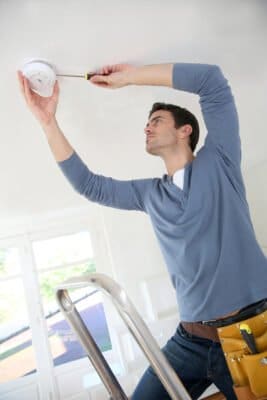

The minimum requirements for the placement and installation of smoke alarms in NSW are laid out in the Environmental Planning and Assessment Regulation 2000 [2] (Regulation 2000). It requires that:-
1) any new buildings where people sleep must contain a smoke alarm fitted in every hallway associated with a bedroom or the section of the building containing the bedroom/s.
2) smoke alarms be installed on every house level, even where there is no bedroom on that level. In which case, alarms must be placed in the path of escape (egress) – such as the landing at the top of the stairs.
The law encompasses owner-occupied homes, relocatable sleep outs and rental properties, camper-vans, caravans and the caravan annex (if people sleep there) plus any other building where people sleep.
Responsibility of Home Owner, Landlord, Agent & Tenants
In a rental situation, it is the landlord’s responsibility to ensure a working fire alarm is in place on every level of the building. When tenants find a smoke alarm not working, they should report this immediately to the landlord, who then has to have the alarms in working order within two business days.
Whether you live in your home or are a landlord or property agent, smoke alarms should be checked and batteries replaced at least once a year. Every ten years, the smoke alarm should also be replaced. Meaning for tenants, it is a good idea to ask when smoke alarms were installed, so you know when they need replacing.
As per tenancy requirements, landlords or their agents must give tenants at least two business days’ notice to inspect the homes smoke alarms and at least 1-hour notice to carry out any required repair or replacement.
Fire & Rescue NSW Recommendation for Installing Smoke Alarms in Homes
Unfortunately, current legal requirements (and building codes) fall woefully short of their intent to protect people and property. With research emerging to support legislative change, investing now is to get ahead of the curve.
Older alarms deteriorate with age and due to dust, insects and humidity. So whether your alarm has reached its ten-year limit or not and because the technology has improved FRNSW is encouraging NSW residents to replace outdated smoke alarms.
FRNSW recommends interconnected alarms in every bedroom, living space (including hallways and stairways) and even the garage in their home.
Admittedly rising to meet the FRNSW recommendations is a deal more expensive than your current legal obligation. Yet I suspect we can agree that ensuring our family and home are protected, as much as possible from the risk of fire, is an excellent investment.
Cost of Smoke Alarms [Price vs Value]
For a reliable and cost-effective option, we recommend photoelectric (or dual sensor) alarms that meet Australian Standards 3786 (AS3786).
However, there are many types of alarms available for purchase, including:-
- photoelectric
- ionisation
- dual/multi detection
- heat detectors
- carbon monoxide alarms
A quick google shows that you can purchase a 10-year photoelectric smoke alarm for as little as $15 from most major supermarkets and hardware supply stores. And while it may be tempting to save money, avoid low quality when it comes to fire safety. As a minimum, purchase an alarm that has standard features such as
- More than 1-year battery life (replace batteries annually)
- Test button
- Hush button
- Battery test
For additional value, alarms may also include
- Escape light
- Enable Interconnection
- Offer features for the hearing impaired
- Insect screen
It is essential to account for more than just the cost to supply and install smoke alarms, you can also account for value in terms of safety, security and well being. What price are you willing to pay for peace of mind? Can you afford more to ensure the safety of your family?
We recommend you talk to a licensed smoke alarm installer like your local electrician, who can provide solid advice about price and quality options within your budget.
Avoiding False Alarms
Every year the vast majority of alarms attend by Fire & Rescue NSW are false alarms.
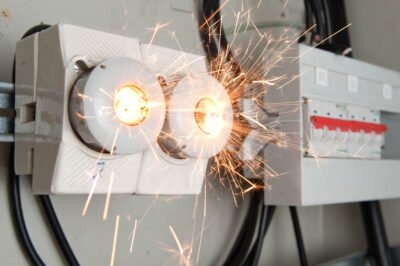

The common causes of false alarms:-
- Poor ventilation
- Burnt cooking
- Steam from showers
- Aerosol sprays such as fragrance or fly spray
- Cigarettes and candles
- Dusty smoke detectors
- Insect infestations
A false fire alarm is better than the real deal, yet the danger is that reoccurring false alarms can create complacency towards genuine warnings. Here are five ways to avoid both false and genuine fire alarms in your home:-
- Do not leave cooking unattended; this includes something as simple as your toaster.
- Do not smoke near smoke detectors. Seems obvious, right?
- Do not spray aerosol near smoke detectors.
- Install ventilation to draw steam from showers and fumes from cooking away from smoke detectors – particularly those located in or around bathrooms and kitchens.
- Ensure electrical safety in and around your home.
Call the team at Absolutely On-Time Electrical today to talk to a qualified electrician about smoke alarm installation and the options available to protect your family in a fire emergency.

